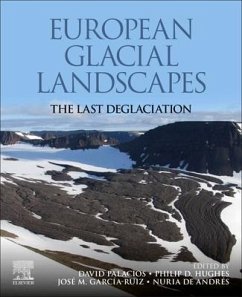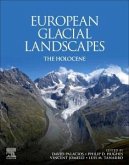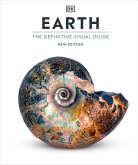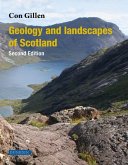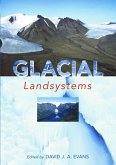European Glacial Landscapes
The Last Deglaciation
Herausgeber: Palacios, David; Hughes, Philip D.; de Andres, Nuria; Garcia-Ruiz, Jose M.
European Glacial Landscapes
The Last Deglaciation
Herausgeber: Palacios, David; Hughes, Philip D.; de Andres, Nuria; Garcia-Ruiz, Jose M.
- Broschiertes Buch
- Merkliste
- Auf die Merkliste
- Bewerten Bewerten
- Teilen
- Produkt teilen
- Produkterinnerung
- Produkterinnerung
European Glacial Landscapes: Last Deglaciation brings together relevant experts on the history of glaciers and their impact on the landscape of the main European regions. Soon after the Last Glacial Maximum, a rapid process of the glacial retreat began throughout Europe. This was interrupted several times by abrupt climate cooling, which caused rapid, although moderate, re-advance of the glaciers, until the beginning of the Holocene when the climate became relatively stable and warm. These successive glacial advances and retreats during the Last Deglaciation have shaped much of the European…mehr
![European Glacial Landscapes European Glacial Landscapes]() European Glacial Landscapes143,99 €
European Glacial Landscapes143,99 €![Earth Earth]() DKEarth31,99 €
DKEarth31,99 €![Geology and Landscapes of Scotland Geology and Landscapes of Scotland]() Con GillenGeology and Landscapes of Scotland51,99 €
Con GillenGeology and Landscapes of Scotland51,99 €![Post-Glacial Post-Glacial]() Robert KroetschPost-Glacial28,99 €
Robert KroetschPost-Glacial28,99 €![Atlantis Glacial Tides Atlantis Glacial Tides]() Allie BurtonAtlantis Glacial Tides14,99 €
Allie BurtonAtlantis Glacial Tides14,99 €![Glacial Glacial]() Chelsea HendersonGlacial20,99 €
Chelsea HendersonGlacial20,99 €![GLACIAL LANDSYSTEMS GLACIAL LANDSYSTEMS]() David EvansGLACIAL LANDSYSTEMS76,99 €
David EvansGLACIAL LANDSYSTEMS76,99 €-
-
-
Hinweis: Dieser Artikel kann nur an eine deutsche Lieferadresse ausgeliefert werden.
- Produktdetails
- Verlag: Elsevier - Health Sciences Division
- Seitenzahl: 644
- Erscheinungstermin: 21. September 2022
- Englisch
- Abmessung: 276mm x 215mm x 37mm
- Gewicht: 1710g
- ISBN-13: 9780323918992
- ISBN-10: 0323918999
- Artikelnr.: 62891222
- Herstellerkennzeichnung
- Libri GmbH
- Europaallee 1
- 36244 Bad Hersfeld
- 06621 890
- Verlag: Elsevier - Health Sciences Division
- Seitenzahl: 644
- Erscheinungstermin: 21. September 2022
- Englisch
- Abmessung: 276mm x 215mm x 37mm
- Gewicht: 1710g
- ISBN-13: 9780323918992
- ISBN-10: 0323918999
- Artikelnr.: 62891222
- Herstellerkennzeichnung
- Libri GmbH
- Europaallee 1
- 36244 Bad Hersfeld
- 06621 890
Cycles. 3. Previous synthesis of Last Deglaciation in Europe
PART II. Climate changes during the Last Deglaciation in the Eastern North
Atlantic region 4. Introduction 5. The Heinrich-1 Stadial 6. The
Bølling-Allerød Interstadial 7. The Younger Dryas Stadial
PART III. The European glacial landforms during main deglaciation
(18.9-14.6 ka) 8. Concept and global context of the glacial landforms from
deglaciation SECTION 1. European regions that were covered by the European
Ice Sheet Complex (EISC) 9. European Ice Sheet Complex evolution during
main deglaciation (18.9-14.6 ka) 10. Fennoscandia: glacial landforms during
deglaciation (18.9-14.6 ka) 11. Northern Central Europe: glacial landforms
during deglaciation (18.9-14.6 ka) 12. European Russia: glacial landforms
during deglaciation (18.9-14.6 ka) 13. The Eurasian Arctic: Glacial
landforms during main deglaciation (18.9-14.6 ka) 14. The North Sea and Mid
Norwegian Continental Margin: glacial landforms during deglaciation, the
Bølling-Allerød Interstadial and the Younger Dryas. 15. Britain and
Ireland: glacial landforms during deglaciation (18.9-14.6 ka). SECTION 2.
European regions that were not covered by the EISC 16. The Polar Ural
Mountains: Deglaciation history. 17. Iceland: glacial landforms during
deglaciation (18.9-14.6 ka) 18. The evolution of glacial landforms in the
Tatra Mountains during deglaciation (18.9-14.6 ka). 19. The Romanian
Carpathians: glacial landforms during deglaciation (18.9-14.6 ka). 20. The
Alps: glacial landforms during deglaciation (18.9 to 14.6 ka). 21. The
Pyrenees: environments and landforms in the aftermath of the LGM (18.9-14.6
ka). 22. The evolution of glacial landforms in Iberian Mountains during
deglaciation (18.9-14.6 ka). 23. The Italian Mountains: glacial landforms
during deglaciation (18.9-14.6 ka). 24. The Balkans: glacial landforms
during deglaciation (18.9-14.6 ka). 25. The Anatolian Mountains: glacial
landforms during deglaciation (18.9-14.6 ka). SECTION 3. Synthesis of Part
III 26. The European glacial landscapes from the main deglaciation
PART IV. The European glacial landforms from the Bølling-Allerød
Interstadial (14.6-12.9 ka) 27. Concept and global context of the glacial
landforms from the Bølling-Allerød Interstadial SECTION 1. European regions
that were covered by the European Ice Sheet Complex (EISC) 28. European Ice
Sheet Complex evolution during the Bølling-Allerød Interstadial (14.6-12.9
ka) 29. Fennoscandia: glacial landforms from the Bølling-Allerød
Interstadial (14.6-12.9 ka). 30. Northern Central Europe: glacial landforms
from the Bølling-Allerød Interstadial 31. European Russia: glacial
landforms from the Bølling-Allerød Interstadial 32. The Eurasian Arctic:
Glacial landforms from the Bølling-Allerød Interstadial (14.6-12.9 ka BP).
33. Britain and Ireland: glacial landforms from the Bølling-Allerød
Interstadial. SECTION 2: European regions that were not covered by the EISC
34. Iceland: Glacial landforms and raised shorelines from the
Bølling-Allerød interstadial. 35. The evolution of glacial landforms in the
Tatra Mountains during the Bølling-Allerød Interstadial. 36. The Romanian
Carpathians: glacial landforms during Bølling -Allerød Interstadial. 37.
The Alps: glacial landforms from the Bølling-Allerød Interstadial 38. The
Pyrenees: glacial landforms from the Bølling-Allerød Interstadial 39. The
evolution of glacial landforms in the Iberian Mountains during
Bølling-Allerød Interstadial. 40. The Italian Mountains: glacial landforms
from the Bølling-Allerød Interstadial 41. The Balkans: glacial landforms
from the Bølling-Allerød Interstadial 42. The Anatolian Mountains: glacial
landforms from the Bølling-Allerød Interstadial SECTION 3. Synthesis of the
Part IV 43. European glacial landscapes from the Bølling-Allerød
Interstadial
PART V. The European glacial landforms from the Younger Dryas Stadial
(12.9-11.7 ka) 44. Concept and global context of the glacial landforms from
Younger Dryas SECTION 1. European regions that were covered by the European
Ice Sheet Complex (EISC) 45. The EISC evolution during the Younger Dryas
Stadial (12.9-11.7 ka). 46. The Fennoscandian Ice Sheet during the Younger
Dryas Stadial. 47. Younger Dryas local moraines in western and northern
Norway 48. Northern Central Europe: glacial landforms from the Younger
Dryas Stadial. 49. European Russia: glacial landforms from the Younger
Dryas Stadial. 50. The Eurasian Arctic:¿Glacial landforms from the Younger
Dryas Stadial. 51. Britain and Ireland: glacial landforms from the Younger
Dryas Stadial SECTION 2. European regions that not were covered by the EISC
52. Iceland: glacial landforms from the Younger Dryas Stadial 53. The
evolution of glacial landforms in the Tatra Mountains during the Younger
Dryas Stadial. 54. The Romanian Carpathians: glacial landforms from the
Younger Dryas 55. The Alps: glacial landforms from the Younger Dryas
Stadial 56. The Pyrenees: glacial landforms from the Younger Dryas Stadial
57. The evolution of glacial landforms in Iberian Mountains during the
Younger Dryas Stadial. 58. The Italian Mountains: glacial landforms from
the Younger Dryas Stadial. 59. The Balkans: glacial landforms from the
Younger Dryas Stadial. 60. The Anatolian Mountains: glacial landforms from
the Younger Dryas Stadial. SECTION 3. Synthesis of Part V 61. The European
glacial landscapes from the Younger Dryas Stadial
PART VI. The Synthesis of the European Landscapes from Last Deglaciation
62. The importance of European glacial landscapes in a context of great
climatic variability
Cycles. 3. Previous synthesis of Last Deglaciation in Europe
PART II. Climate changes during the Last Deglaciation in the Eastern North
Atlantic region 4. Introduction 5. The Heinrich-1 Stadial 6. The
Bølling-Allerød Interstadial 7. The Younger Dryas Stadial
PART III. The European glacial landforms during main deglaciation
(18.9-14.6 ka) 8. Concept and global context of the glacial landforms from
deglaciation SECTION 1. European regions that were covered by the European
Ice Sheet Complex (EISC) 9. European Ice Sheet Complex evolution during
main deglaciation (18.9-14.6 ka) 10. Fennoscandia: glacial landforms during
deglaciation (18.9-14.6 ka) 11. Northern Central Europe: glacial landforms
during deglaciation (18.9-14.6 ka) 12. European Russia: glacial landforms
during deglaciation (18.9-14.6 ka) 13. The Eurasian Arctic: Glacial
landforms during main deglaciation (18.9-14.6 ka) 14. The North Sea and Mid
Norwegian Continental Margin: glacial landforms during deglaciation, the
Bølling-Allerød Interstadial and the Younger Dryas. 15. Britain and
Ireland: glacial landforms during deglaciation (18.9-14.6 ka). SECTION 2.
European regions that were not covered by the EISC 16. The Polar Ural
Mountains: Deglaciation history. 17. Iceland: glacial landforms during
deglaciation (18.9-14.6 ka) 18. The evolution of glacial landforms in the
Tatra Mountains during deglaciation (18.9-14.6 ka). 19. The Romanian
Carpathians: glacial landforms during deglaciation (18.9-14.6 ka). 20. The
Alps: glacial landforms during deglaciation (18.9 to 14.6 ka). 21. The
Pyrenees: environments and landforms in the aftermath of the LGM (18.9-14.6
ka). 22. The evolution of glacial landforms in Iberian Mountains during
deglaciation (18.9-14.6 ka). 23. The Italian Mountains: glacial landforms
during deglaciation (18.9-14.6 ka). 24. The Balkans: glacial landforms
during deglaciation (18.9-14.6 ka). 25. The Anatolian Mountains: glacial
landforms during deglaciation (18.9-14.6 ka). SECTION 3. Synthesis of Part
III 26. The European glacial landscapes from the main deglaciation
PART IV. The European glacial landforms from the Bølling-Allerød
Interstadial (14.6-12.9 ka) 27. Concept and global context of the glacial
landforms from the Bølling-Allerød Interstadial SECTION 1. European regions
that were covered by the European Ice Sheet Complex (EISC) 28. European Ice
Sheet Complex evolution during the Bølling-Allerød Interstadial (14.6-12.9
ka) 29. Fennoscandia: glacial landforms from the Bølling-Allerød
Interstadial (14.6-12.9 ka). 30. Northern Central Europe: glacial landforms
from the Bølling-Allerød Interstadial 31. European Russia: glacial
landforms from the Bølling-Allerød Interstadial 32. The Eurasian Arctic:
Glacial landforms from the Bølling-Allerød Interstadial (14.6-12.9 ka BP).
33. Britain and Ireland: glacial landforms from the Bølling-Allerød
Interstadial. SECTION 2: European regions that were not covered by the EISC
34. Iceland: Glacial landforms and raised shorelines from the
Bølling-Allerød interstadial. 35. The evolution of glacial landforms in the
Tatra Mountains during the Bølling-Allerød Interstadial. 36. The Romanian
Carpathians: glacial landforms during Bølling -Allerød Interstadial. 37.
The Alps: glacial landforms from the Bølling-Allerød Interstadial 38. The
Pyrenees: glacial landforms from the Bølling-Allerød Interstadial 39. The
evolution of glacial landforms in the Iberian Mountains during
Bølling-Allerød Interstadial. 40. The Italian Mountains: glacial landforms
from the Bølling-Allerød Interstadial 41. The Balkans: glacial landforms
from the Bølling-Allerød Interstadial 42. The Anatolian Mountains: glacial
landforms from the Bølling-Allerød Interstadial SECTION 3. Synthesis of the
Part IV 43. European glacial landscapes from the Bølling-Allerød
Interstadial
PART V. The European glacial landforms from the Younger Dryas Stadial
(12.9-11.7 ka) 44. Concept and global context of the glacial landforms from
Younger Dryas SECTION 1. European regions that were covered by the European
Ice Sheet Complex (EISC) 45. The EISC evolution during the Younger Dryas
Stadial (12.9-11.7 ka). 46. The Fennoscandian Ice Sheet during the Younger
Dryas Stadial. 47. Younger Dryas local moraines in western and northern
Norway 48. Northern Central Europe: glacial landforms from the Younger
Dryas Stadial. 49. European Russia: glacial landforms from the Younger
Dryas Stadial. 50. The Eurasian Arctic:¿Glacial landforms from the Younger
Dryas Stadial. 51. Britain and Ireland: glacial landforms from the Younger
Dryas Stadial SECTION 2. European regions that not were covered by the EISC
52. Iceland: glacial landforms from the Younger Dryas Stadial 53. The
evolution of glacial landforms in the Tatra Mountains during the Younger
Dryas Stadial. 54. The Romanian Carpathians: glacial landforms from the
Younger Dryas 55. The Alps: glacial landforms from the Younger Dryas
Stadial 56. The Pyrenees: glacial landforms from the Younger Dryas Stadial
57. The evolution of glacial landforms in Iberian Mountains during the
Younger Dryas Stadial. 58. The Italian Mountains: glacial landforms from
the Younger Dryas Stadial. 59. The Balkans: glacial landforms from the
Younger Dryas Stadial. 60. The Anatolian Mountains: glacial landforms from
the Younger Dryas Stadial. SECTION 3. Synthesis of Part V 61. The European
glacial landscapes from the Younger Dryas Stadial
PART VI. The Synthesis of the European Landscapes from Last Deglaciation
62. The importance of European glacial landscapes in a context of great
climatic variability

